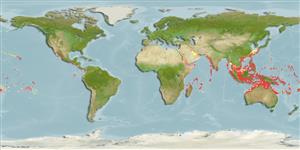Common names from other countries
Environment: milieu / climate zone / depth range / distribution range
экология
морской ассоциированный с рифами; немигрирующий; пределы глубины 10 - 100 m (Ref. 90102), usually 25 - ? m (Ref. 90102). Tropical; 32°N - 23°S
Indo-Pacific: Red Sea and South Africa (Ref. 11228) to the Hawaiian Islands, north to southern Japan, south to New Caledonia. Eastern Pacific: Gulf of California to northern Colombia and the Galapagos Islands (Ref. 9289).
Size / Вес / Возраст
Maturity: Lm ? range ? - ? cm
Max length : 13.0 cm TL самец/пол неопределен; (Ref. 9289)
Краткое описание
определительные ключи | морфология | морфометрия
колючие лучи спинного плавника (общее число) : 10; членистые (мягкие) лучи спинного плавника (общее число) : 13; колючие лучи анального плавника: 3; членистые (мягкие) лучи анального плавника: 7.
Inhabits steep outer reef slopes exposed to strong currents where it lives in large gorgonians and black corals (Ref. 3921). Benthic (Ref. 58302). Common below 25 m (Ref. 90102). Feeds on small benthic or planktonic crustaceans. The suggestion that this species lays demersal eggs (Ref. 3921) is questionable. Pelagic spawning has been observed for this species from field observations (Ref. 26305). Monogamous (Ref. 52884), strongly territorial (Ref. 26305). Uncommon to rare in most areas (Ref. 9710).
Life cycle and mating behavior
Maturities | размножение | Spawnings | Egg(s) | Fecundities | личинки
Distinct pairing (Ref. 52884). Actual spawning lasts about 1-2 seconds while ascending a distance of less than 0.25 m (Ref. 26305). Courtship and spawning behavior is similar to that described for other species: 1) courtship commences just before or after sunset with spawning after sunset; 2) successive courtship and spawning by the male in social groups containing one or more females; 3) courtship and spawning at a site common to both male and female or at a site located within the female's home area; 4) pelagic spawning with a rapid but relatively short ascent into the water column by both male and female; 5) return of the male and female to resident corals afte spawning.
Monogamous mating is observed as both facultative and social (Ref. 52884).
Myers, R.F., 1991. Micronesian reef fishes. Second Ed. Coral Graphics, Barrigada, Guam. 298 p. (Ref. 1602)
Статус Красного Списка МСОП (Ref. 130435)
CITES (Ref. 128078)
Not Evaluated
Угроза для людей
Harmless
Использование человеком
рыболовство: интереса не представляет; аквариум: коммерческий
дополнительная информация
инструменты
Специальные отчеты
Скачать в формате XML
ресурсы в Интернет
Estimates based on models
Preferred temperature (Ref.
115969): 24.9 - 29, mean 28 (based on 1414 cells).
Phylogenetic diversity index (Ref.
82804): PD
50 = 1.0000 [Uniqueness, from 0.5 = low to 2.0 = high].
Bayesian length-weight: a=0.00389 (0.00180 - 0.00842), b=3.12 (2.94 - 3.30), in cm Total Length, based on all LWR estimates for this body shape (Ref.
93245).
Trophic level (Ref.
69278): 3.3 ±0.37 se; based on food items.
Fishing Vulnerability (Ref.
59153): Low vulnerability (10 of 100).
